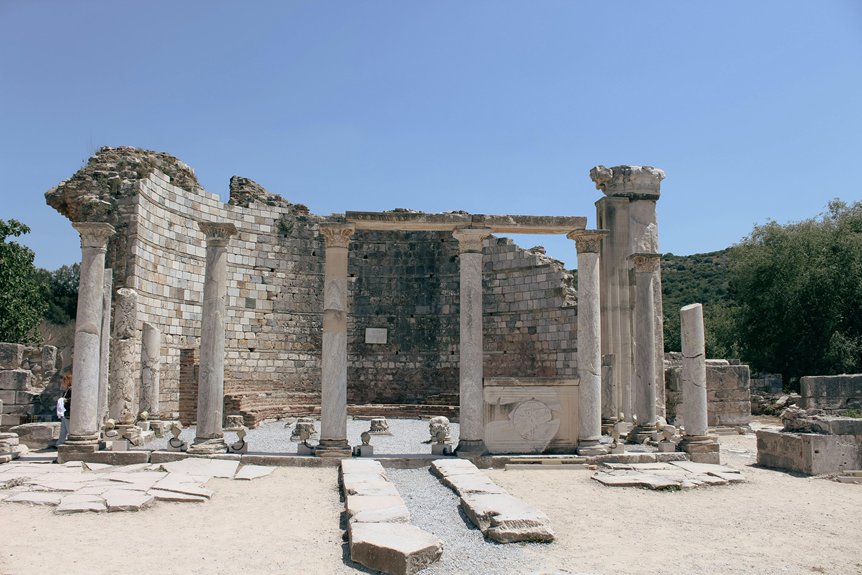Paphos’ archaeological sites are UNESCO-worthy due to their exceptional mosaics, such as those in the House of Dionysus, which illustrate Greek mythology and daily life with intricate artistry. The sites span various eras, showcasing a rich cultural tapestry from the Neolithic to Byzantine periods, with landmarks like the Tombs of the Kings offering insights into ancient burial customs. The cult of Aphrodite adds mythological significance, making Paphos a cultural and spiritual hub. Preservation efforts guarantee authenticity, maintaining their historical integrity and artistic legacy. Explore further to uncover the depth of Paphos’ archaeological treasures.
Punti di forza
- Exceptional Roman-era mosaics depicting mythology and daily life, comparable to Sicily’s Villa Romana del Casale, exemplify artistic excellence and historical significance.
- The architectural richness of ruins spanning Neolithic to Byzantine periods offers a unique cultural tapestry and insight into ancient civilizations.
- Paphos’ association with Aphrodite’s mythology, including her sanctuary and temple, underscores its spiritual and historical importance.
- The Tombs of the Kings, with elaborate underground chambers, reflect Hellenistic architectural influences and ancient burial customs of high-ranking officials.
- Robust preservation efforts, including UNESCO recognition, ensure the authenticity and protection of these archaeological treasures for future generations.
The Exceptional Mosaics of Paphos
The mosaics of Paphos are celebrated for their intricate and vivid depictions of Greek mythology and everyday life, crafted between the 2nd and 4th centuries AD. You’ll find these masterpieces in ancient Roman villas like the House of Dionysus and the House of Aion, where they remain remarkably preserved in their original settings. This in situ preservation was a key factor in earning Paphos its UNESCO World Heritage recognition, highlighting its archaeological significance. As one of Cyprus’ most prized UNESCO sites, the mosaics rival the famous Villa Romana del Casale in Sicily for artistic excellence. They offer a rare glimpse into the cultural and artistic traditions of the Roman era in Cyprus, making them a treasure of global importance. Their exceptional craftsmanship and vivid storytelling underscore why ancient Paphos is a cornerstone of archaeological study and appreciation, enriching our understanding of history.
The Ancient Ruins and Historical Landmarks
Spanning periods from the Neolithic era to the Byzantine age, Paphos’ ancient ruins and historical landmarks reveal a rich cultural tapestry that has captivated archaeologists and historians alike. These sites, spanning thousands of years, provide a rare glimpse into the island’s diverse history, from early settlements to Roman and Byzantine influences. The Roman mosaics, particularly those in the House of Dionysus, showcase remarkable artistry, while the Tombs of the Kings, with their elaborate underground chambers, highlight ancient burial customs. These ruins are not just remnants of the past but living legacies to the ingenuity and traditions of bygone eras. Their meticulous preservation guarantees their authenticity, making them invaluable to understanding humanity’s cultural evolution. This blend of historical depth and archaeological significance solidifies Paphos’ place as a UNESCO World Heritage Site, offering insights into civilizations that shaped the Mediterranean world.
The Cult of Aphrodite and Mythological Significance
Beneath Paphos’ layers of history lies a profound connection to Aphrodite, the Greek goddess of love and fertility, whose legendary birthplace is said to be nearby. The Aphrodite Sanctuary at Kouklia, part of the UNESCO site, stands as a tribute to her enduring influence. This sanctuary, once a major center of worship, now houses a museum showcasing artifacts, including a dark rock symbolizing the goddess, linking the site to centuries of devotion. The Temple of Aphrodite, built by the Mycenaeans in the 12th century BC, further cements Paphos’ status as a religious and cultural hub. The cult of Aphrodite has inspired writers, poets, and artists, enriching the site’s cultural significance. UNESCO has recognized Paphos for its role in preserving Aphrodite’s mythology, acknowledging its spiritual and historical importance, making it an essential part of our shared heritage.
The Tombs of the Kings and Burial Practices
How did an ancient necropolis become one of Paphos’ most fascinating archaeological treasures? The Tombs of the Kings, a sprawling underground burial site, captivates visitors with its intricate architecture and historical significance. Carved into solid rock during the Hellenistic and Roman periods (3rd century BC to 3rd century AD), these tombs were designed to resemble the homes of the elite, complete with burial chambers and peristyle atriums adorned with Doric columns. Here are three key insights into their importance:
- Architectural Grandeur: The tombs mirror the living quarters of the wealthy, showcasing advanced engineering and artistic skill.
- Social Hierarchy: Despite their name, the tombs were not for royalty but for high-ranking officials, reflecting the era’s social structure.
- Cultural Ties: Their Hellenistic design, similar to tombs in Alexandria, highlights Paphos’ connection to the broader Mediterranean world.
These well-preserved tombs offer a glimpse into ancient burial practices and architectural innovation, earning their place as a UNESCO-recognized site.
The Integrity and Preservation of the Archaeological Sites
Paphos Archaeological Sites have been safeguarded as a UNESCO World Heritage site since 1980, recognized for their unique cultural significance and enduring connection to Aphrodite’s myth. These sites in Kato Paphos and Kouklia are meticulously preserved to retain their authenticity, with conservation efforts prioritizing structural safety while respecting original materials. Controlled Areas regulate nearby development to protect the sites’ integrity, ensuring their Outstanding Universal Value remains intact. A Master Plan for Kato Paphos, in place since 1991, guides conservation and promotion, with a second phase ongoing. Similar efforts are being made for Palaepaphos. Ownership largely lies with the government, under Cyprus’ Antiquities Law, providing strong legal protection. Funding from the national budget supports maintenance, ensuring these archaeological treasures endure for future generations. This commitment to preservation underscores their importance as a cultural and historical legacy, solidifying their status as a UNESCO World Heritage site.
The Cultural and Artistic Contributions to Humanity
The archaeological sites of Paphos present a wealth of cultural treasures that have profoundly influenced humanity. These sites are a window into the artistic and cultural evolution of the ancient world, offering insights into myth, art, and architecture. Here are three key ways Paphos has shaped cultural and artistic heritage:
- Exceptional Roman Mosaics: The mosaics in the House of Dionysus and Villa of Theseus vividly depict Greek mythology, preserving themes of fertility and love that have inspired art and literature across centuries.
- Mythological Significance: As Aphrodite’s mythical birthplace, Paphos embodies themes of love and fertility, deeply influencing Western culture and shaping artistic expression.
- Archaeological Continuum: The site spans periods from Neolithic to Byzantine, offering a rare glimpse into the evolution of art and design across civilizations.
These treasures are not only preserved but also celebrated as a tribute to humanity’s shared cultural legacy.
The Unique Architecture and Historical Evolution
Beyond the artistic treasures, the architectural landscape of Paphos unfolds as an enchanting journey through time, reflecting centuries of cultural exchange and historical transformation. The city’s buildings, from the Mycenaean period to Roman and Byzantine influences, reveal a dynamic evolution shaped by its position as a crossroads of civilizations. The Temple of Aphrodite, a Mycenaean marvel, and the Roman villas with their intricate mosaics, showcase a blend of Greek and Roman architectural traditions. The Tombs of the Kings, carved into solid rock during the Hellenistic and Roman periods, echo Alexandrian prototypes, emphasizing Paphos’ role in ancient funerary practices. These structures, preserved alongside sites like the Odeon and Agora, highlight the city’s shift from an ancient metropolis to a UNESCO-recognized heritage site. Together, they illustrate the historical and archaeological significance of Paphos, where every stone tells a story of cultural fusion and enduring legacy.
Domande frequenti
Is Paphos a UNESCO World Heritage Site?
Yes, Paphos is a UNESCO World Heritage Site, inscribed in 1980. You’ll discover its historical significance through its archaeological areas, such as Kato Paphos and Kouklia, which showcase ancient ruins and cultural landmarks. These sites preserve remnants of Cyprus’s rich history, aligning with UNESCO’s criteria for cultural tradition and its legendary ties to Aphrodite. Covering 162 hectares, Paphos was also granted enhanced protection in 2010, highlighting its enduring archaeological value.
What Is Special About UNESCO World Heritage Sites?
UNESCO World Heritage Sites are designated for their exceptional cultural, historical, or natural significance. They represent the best of human creativity, the evolution of civilizations, or unique natural landscapes. Preservation efforts guarantee these treasures are protected for future generations. You experience the essence of humanity’s shared heritage when visiting these sites, which are considered irreplaceable and essential for understanding our past and shaping our future. Their global recognition underscores their universal value and the importance of safeguarding them.
What Is the Unesco Heritage of Cyprus?
You find yourself exploring Cyprus’s UNESCO heritage, and Paphos stands out as a crown jewel. A treasure trove of history, it’s where you uncover ruins spanning the Neolithic to Roman eras. The Tombs of the Kings and vibrant mosaics captivate your imagination. Its ties to Aphrodite add a mythological charm. As you wander, you realize the site’s preservation efforts safeguard its legacy for future generations. Cyprus’s UNESCO heritage is evidence of its rich past and cultural stewardship.
What Is One Interesting Fact About Paphos?
Paphos is renowned for its stunning Roman mosaics, which are a key reason for its UNESCO status. The intricate designs in sites like the House of Dionysus showcase exceptional craftsmanship. These remarkably preserved mosaics offer a vivid glimpse into ancient Roman life in Cyprus. Walking through the ruins, you’re stepping into a blade of history, making Paphos a fascinating destination for those fascinated by the past.
Conclusione
Walking through Paphos’ archaeological sites, you’re immersed in history. Sites like the Tombs of the Kings, with their grand Hellenistic architecture, showcase elaborate burial practices. These tombs are a UNESCO-worthy testimony to Cyprus’ rich past, blending art, mythology, and culture, exemplifying the preservation of ancient heritage that resonates globally.

Vi presentiamo Natalie, che vive a Cipro da 10 anni. Ama esplorare la splendida natura dell'isola, come le foreste silenziose e le spiagge incontaminate. Natalie ha molte esperienze interessanti da condividere. Scoprite con lei le sue avventure a Cipro.

